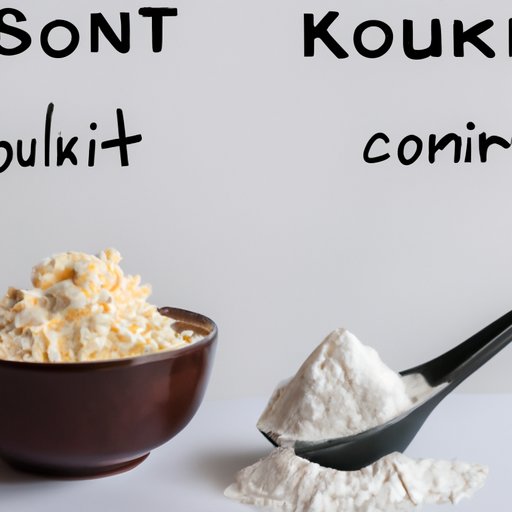
I. Introduction
When cooking or baking, it’s not uncommon to come across a recipe that relies on a thickening agent to create the desired texture. Many people wonder whether it’s possible to substitute flour for cornstarch and vice versa, particularly when one ingredient is missing from the pantry. In this article, we’ll explore whether it’s possible to substitute flour for cornstarch and provide you with helpful tips for cooking and baking with both ingredients.
II. “Flour or Cornstarch: Which One to Use for Thickening?”
Flour and cornstarch are the two most commonly used thickening agents in cooking and baking. However, they have some differences. Cornstarch is a finer powder that comes from corn, while flour is a coarser powder made from wheat grains.
Cornstarch has twice the thickening power of flour, meaning that it can thicken liquids with half the amount of flour required. Although cornstarch is more effective in thickening sauces or gravy, it can make a dish appear translucent and gives a gummy texture if overused. Flour, on the other hand, has a grainy texture that makes it best for dishes that don’t require a smooth texture.
If you’re missing one of these ingredients, it’s usually possible to substitute the other in a pinch, depending on the recipe. But it’s essential to keep in mind that the results may vary.
III. “Baking with Cornstarch: Can It Be Done?”
Cornstarch can be used as a substitute for flour in baking, although it won’t work in every recipe. It’s essential to consider the recipe’s texture and the taste before replacing the flour with cornstarch.
Using cornstarch instead of flour results in a tender, crumbly, and more delicate texture, but using too much cornstarch can leave your baked goods with a chalky taste. Cornstarch also produces less gluten than flour, which can cause difficulty in rising dough and result in a denser cake.
If you’re looking for recipes to try substituting flour with cornstarch, consider starting with recipes for shortbread cookies or sponge cakes that require a light and delicate texture.
IV. “All-Purpose Flour vs. Cornstarch: Which Should You Stock in Your Pantry?”
When it comes to choosing between all-purpose flour and cornstarch for your pantry, it depends on the recipe you’ll be making.
All-purpose flour is more versatile as it can be used to make bread, cakes, pastries, and more. On the other hand, cornstarch is best for making sauces, gravies, and pudding due to its smoother texture.
Cornstarch is also a popular alternative for those with gluten-free diets because it doesn’t contain gluten. However, it’s essential to keep in mind that removing gluten also means removing some of the structure essential for baked goods, especially bread and cakes, to rise. Gluten-free flours can be combined with cornstarch to make up for the lost structure.
V. “The Best Recipes for Substituting Flour with Cornstarch”
If you’re looking to substitute flour with cornstarch in some of your recipes, you can start with the following dishes:
- Stir-fry dishes: cornstarch is an excellent thickener for stir-fries because it creates a clear and shiny sauce.
- Soup: using cornstarch instead of flour creates a smoother texture in soups.
- Pudding: cornstarch creates a classic, smooth, and velvety pudding texture.
It’s important to note that not all recipes will work with this substitute, and it’s best to test a small amount before adding it to the whole recipe.
VI. “How to Use Cornstarch as a Natural Thickener”
One of the benefits of substituting cornstarch for flour is that it’s a natural thickener. Cornstarch is gluten-free and not genetically modified, unlike many flour types. Here are some dishes and recipes to consider using cornstarch as a natural thickener:
- Asian-style sauce: use a combination of cornstarch and water to create a thick and glossy sauce for your stir-fry dishes.
- Berry sauce: use cornstarch to thicken berry sauces, such as strawberry sauce, to create the desired thickness.
- Cherry pie filling: use cornstarch to thicken your cherry pie filling while also adding a glossy sheen to the dish.
VII. Conclusion
In conclusion, flour and cornstarch serve different purposes in cooking and baking. While both ingredients can be substituted for one another, it’s essential to keep in mind the recipe’s texture, flavor, and other factors that may impact the outcome. By following these tips and recipes, you can achieve excellent results using either flour or cornstarch in your dishes or baking.
Whether you’re looking for a gluten-free alternative or just experimenting with your recipes, substituting flour for cornstarch and vice versa can be a fun and exciting way to breathe new life into your cooking and baking.




